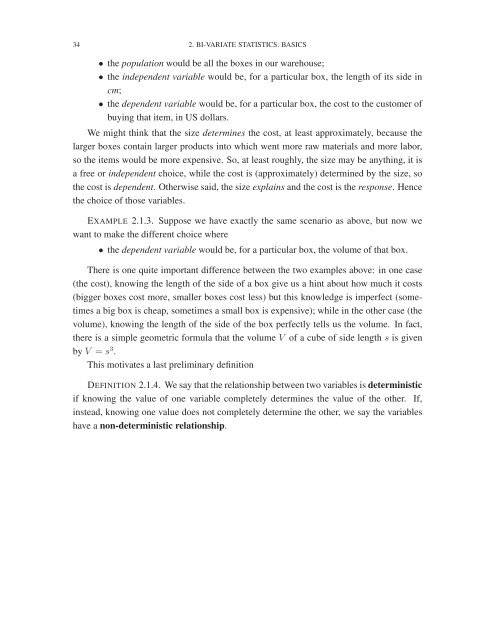Lies, Damned Lies, or Statistics- How to Tell the Truth with Statistics, 2017a
Lies, Damned Lies, or Statistics- How to Tell the Truth with Statistics, 2017a
Lies, Damned Lies, or Statistics- How to Tell the Truth with Statistics, 2017a
Create successful ePaper yourself
Turn your PDF publications into a flip-book with our unique Google optimized e-Paper software.
34 2. BI-VARIATE STATISTICS: BASICS<br />
• <strong>the</strong> population would be all <strong>the</strong> boxes in our warehouse;<br />
• <strong>the</strong> independent variable would be, f<strong>or</strong> a particular box, <strong>the</strong> length of its side in<br />
cm;<br />
• <strong>the</strong> dependent variable would be, f<strong>or</strong> a particular box, <strong>the</strong> cost <strong>to</strong> <strong>the</strong> cus<strong>to</strong>mer of<br />
buying that item, in US dollars.<br />
We might think that <strong>the</strong> size determines <strong>the</strong> cost, at least approximately, because <strong>the</strong><br />
larger boxes contain larger products in<strong>to</strong> which went m<strong>or</strong>e raw materials and m<strong>or</strong>e lab<strong>or</strong>,<br />
so <strong>the</strong> items would be m<strong>or</strong>e expensive. So, at least roughly, <strong>the</strong> size may be anything, it is<br />
a free <strong>or</strong> independent choice, while <strong>the</strong> cost is (approximately) determined by <strong>the</strong> size, so<br />
<strong>the</strong> cost is dependent. O<strong>the</strong>rwise said, <strong>the</strong> size explains and <strong>the</strong> cost is <strong>the</strong> response. Hence<br />
<strong>the</strong> choice of those variables.<br />
EXAMPLE 2.1.3. Suppose we have exactly <strong>the</strong> same scenario as above, but now we<br />
want <strong>to</strong> make <strong>the</strong> different choice where<br />
• <strong>the</strong> dependent variable would be, f<strong>or</strong> a particular box, <strong>the</strong> volume of that box.<br />
There is one quite imp<strong>or</strong>tant difference between <strong>the</strong> two examples above: in one case<br />
(<strong>the</strong> cost), knowing <strong>the</strong> length of <strong>the</strong> side of a box give us a hint about how much it costs<br />
(bigger boxes cost m<strong>or</strong>e, smaller boxes cost less) but this knowledge is imperfect (sometimes<br />
a big box is cheap, sometimes a small box is expensive); while in <strong>the</strong> o<strong>the</strong>r case (<strong>the</strong><br />
volume), knowing <strong>the</strong> length of <strong>the</strong> side of <strong>the</strong> box perfectly tells us <strong>the</strong> volume. In fact,<br />
<strong>the</strong>re is a simple geometric f<strong>or</strong>mula that <strong>the</strong> volume V of a cube of side length s is given<br />
by V = s 3 .<br />
This motivates a last preliminary definition<br />
DEFINITION 2.1.4. We say that <strong>the</strong> relationship between two variables is deterministic<br />
if knowing <strong>the</strong> value of one variable completely determines <strong>the</strong> value of <strong>the</strong> o<strong>the</strong>r. If,<br />
instead, knowing one value does not completely determine <strong>the</strong> o<strong>the</strong>r, we say <strong>the</strong> variables<br />
have a non-deterministic relationship.

















